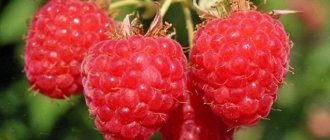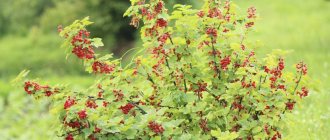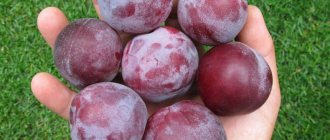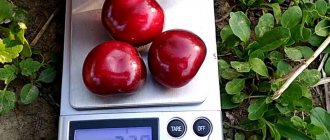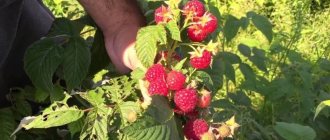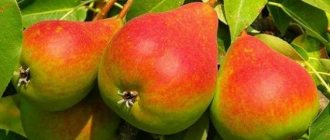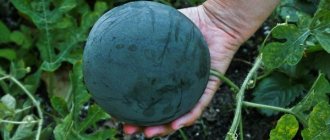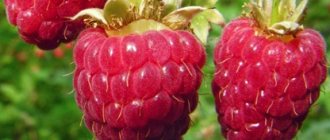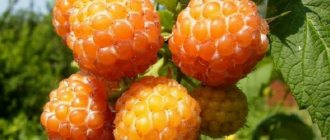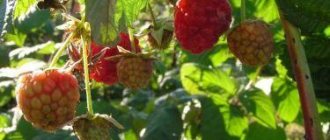The non-repairing raspberry “Skromnitsa” was accepted for state variety testing back in 1982, and the description of the variety and its characteristics were included in the State Register in 1990.
The variety is recommended for cultivation in private plots of the North-Western, Central, Volga-Vyatka, Central Black Earth, North Caucasus, West Siberian and Middle Volga regions, including the Tula, Ryazan, Smolensk and Kemerovo regions, where the Skromnitsa raspberry has become very popular . The author of this variety was the breeder I.V. Kazakov, well-known to gardeners.
Brief history of the variety's creation
The modest one was bred in the Kokinsky branch of the State Scientific Institution VSTISP in the early 80s of the twentieth century, the head of the breeding work was the famous Soviet and Russian breeder Kazakov I.V., who during his life bred more than 20 varieties of remontant raspberries. In 1982, variety testing began, and in 1990 the variety was included in the State Register of the Russian Federation and recommended for cultivation in almost the entire European part of Russia, the entire territory of Ukraine, and even in some regions of Siberia (Kemerovo region). When carrying out breeding work, the Bulgarian ruby variety was taken as a basis.
Description
Refers to varieties of medium ripening. In the southern regions, the harvest is harvested already in the first ten days of July, moving north, the berries ripen later - the second half of July.
The purpose of the berries is universal: suitable for fresh consumption, processing and freezing. A nice feature is the fact that Shyness has a fairly strong immunity to most diseases and pests. It tolerates drought and winter frosts down to -32°C well, which explains the possibility of its cultivation in the Urals and Siberia.
Bushes
The bush is of medium height, can reach 2 m. Thornless, slightly spreading shoots grow straight. Only the root area of the shoots is covered with thorns. The bushes have an average ability to form shoots. The bark of the bush and shoots is quite resistant to damping off.
Berries
The berries are small in size and weight (2.5–3.5 g). The shape is typical for the culture, round, cone-shaped. The fruits have a fairly dense structure and do not have a pronounced odor. Expert tasters rate the taste qualities above average (4.2 points). The berries are collected in clusters and ripen almost at the same time, which makes harvesting much easier. In addition, it should be noted that the berry is easily separated from the stalk.
Some characteristics of the berries:
- sugar-acid index: 6.7;
- carbohydrate content: 6.7%;
- vitamin C: 25 mg/100 g;
- vitamin P: 54 mg/100 g.
Yield indicators
The yield of the variety is, on average, 2.2–2.6 kg per bush. With industrial cultivation, indicators can reach 75–90 c/ha, and when using advanced agricultural techniques, the yield can increase to 110–120 c/ha.
Planting seedlings on the site
Above we said that planting can be done by completely digging up or in trenches. Below we will discuss planting patterns in more detail and also indicate the best time.
Deadlines
If raspberries are planted in the spring, then you need to choose a moment when the flow of juices into the trees has not begun, in order to minimize injury to the plant.
If planting is carried out in the fall, then it is advisable to do this after the trees lose their leaves, otherwise the raspberries may begin to grow when it is necessary to prepare for winter.
Scheme
When planting Shyness in rows, it is worth considering that the distance between neighboring plants should be at least 40 cm. It is better to step back a little more so as not to waste time on thinning later.
It is worth understanding that the suction area depends on how quickly the soil becomes depleted and how much nutrients each individual bush can receive. The distance between rows should be about 2 m.
This indentation is made in order to increase the area for each plant, as well as to give you the opportunity to calmly approach each bush and carry out pruning or garter work, if required.
If you are not planting bushes using a trench method, you can use another scheme - 2x1 m. In this case, the first value is responsible for the distance between arbitrary rows, and the second - between the bushes.
Pros and cons of the variety
- The Shy One, despite its name, has impressive positive characteristics:
- planting and care are very simple and do not require special skills or conditions;
- thornless bushes are easy to cultivate, care for and harvest;
- for commercial (industrial) breeding, mechanized harvesting can be used;
- excellent taste and product quality;
- during transportation and storage, the attractive appearance remains for quite a long time;
- tolerates frosty winters and drought well;
- immune to some diseases (anthracnose, fungal diseases) that pose a danger to most other crop varieties.
Did you know? Garden raspberries differ from wild (forest) raspberries in their larger size and weight of berries, however, the forest variety contains more useful substances.
The description of the variety's disadvantages will be much shorter -
this is poor resistance to gray mold and spider mites .
Reproduction methods
There are 5 main ways to propagate raspberries. All methods are somewhat similar, but have their own specifics, which will be discussed in more detail below.
Reproduction by lignified offspring. The simplest method of culture propagation. On the root system of the bush, lignified shoots grow from adventitious buds. For further breeding, the healthiest offspring are selected, which are dug up in the first half of autumn.
When choosing a shoot, preference should be given to those that grow no closer than 30 cm from the parent bush. You should dig out the shoot carefully, trying not to damage its roots. Shoots that have the slightest signs of disease, especially on the roots (swellings, galls, spots, cancerous growths) should not be used for propagation.
Important! All green matter must be removed from dug out lignified shoots.
Green offspring of the root system. The procedure for digging up offspring is carried out in the spring. At this time, root shoots reach 12–20 cm in height. In order to get a good quality seedling, it is dug up about 40 cm from the center of the bush. The offspring must be dug out with a clod of soil. The shoot must be healthy, without the slightest signs of wilting at the top (a characteristic indicator of damage to the shoot by the raspberry fly). Selected offspring are planted in the ground for subsequent growing, and in the fall they are planted in the traditional way.
Root cuttings . The method is especially effective if the plant stems are affected by any disease. Suitable for both spring and autumn propagation. Very carefully, at a distance of about 40 cm from the bush, dig a hole from which the adventitious root is taken out, trying to preserve all its shoots and branches as much as possible.
All healthy roots with a diameter of 3 mm or more are cut into pieces up to 10 cm long, so that each has a pair of buds. All overgrown roots must be preserved. The petioles are planted in grooves 6–10 cm deep, dug in prepared soil. The cuttings are laid out in a row, one after another, leaving no free space between them. The ditch is filled with soil and watered abundantly.
Green cuttings. For this method, root suckers are used, pruned when thinning raspberries. In late spring - early summer, young shoots (10–15 cm tall) are selected, which have at least 2-3 green leaves.
All shoots that meet the specified requirements are cut at the root, carefully tied into 12–15 cuttings, and placed in a growth stimulator (for example, “Heteroauxin”) for 16–18 hours. Then the cuttings can be planted in a greenhouse. After 20–30 days of growing in a greenhouse, the cuttings will take root. Then they can be dug up and planted in open ground for subsequent growing.
Dividing the bush . The method is used for valuable crop varieties that produce a small number of root shoots. The bush is carefully divided so that each part has at least 2-3 strong, healthy shoots and a well-developed root system. Thus, from one mother bush you can get 4-5 viable seedlings.
Choosing a landing site
In order for raspberries to develop well and bear fruit, they need to choose a place that meets its requirements.
The soil
The soil for cultivating raspberries should be light, slightly acidic or neutral with a large amount of organic matter. The depth of the arable layer should be at least 35-40 cm. You also need to monitor the level of groundwater. It is advisable that it be no higher than 1.5 meters.
Lighting
Raspberries are a light-loving crop. Therefore, unshaded areas are chosen for growing it in the garden. At the same time, you need to ensure that they are protected from strong winds.
In summer, the wind not only contributes to faster drying of the soil, but also increases the evaporation of moisture from the surface of the leaves. This negatively affects the development of the plant as a whole, as well as the size and number of fruits.
Also, when choosing a site, you need to ensure that there is a sufficiently thick snow cover there in winter. This will protect the raspberries from freezing.
Also, when placing raspberry plantings, it is advisable to ensure that there are no crops near them that have similar diseases.
Landing
Raspberries can be planted both in autumn and spring. The soil for planting is prepared in advance.
This crop will grow in one place for about 10 years. Therefore, a fairly large amount of organic matter is introduced into the soil. On average, about 2 buckets of humus or compost are added per 1 square meter, as well as 40 g of double superphosphate and calcium chloride.
Raspberry fruits “Skromnitsa” (photo)
Instead of continuous digging, you can lay trenches for planting raspberries, which are also filled with organic matter and mineral fertilizers. The width of the trenches ranges from 40 to 60 cm, the depth is usually no more than 40 cm.
If the soil on the site is acidic, it is necessary to lime it. To do this, about 400-500 g of lime is added for each square meter of digging. When groundwater is close to each other, raised ridges are created for planting raspberries.
Most often, raspberries are planted in one or several rows. In this case, the distance between plants should be from 40 to 50 cm. And between the rows, depending on the variety, from 1.5 to 2 meters.
When planting, seedlings should be buried only to the level of the root collar. Planting deeper may result in the death of the plant.
Immediately after planting is completed, the raspberry shoots are cut to a height of 30 cm and the soil under the bushes is well drained. It is also advisable to make a layer of mulch 7-8 cm thick. Rotted manure or peat can be used for mulching.
Expert opinion
Yulia Yurievna
I have a large garden and vegetable garden, several greenhouses. I love modern methods of cultivating plants and mulching the soil, and I share my experience.
Ask a Question
The soil for raspberries should really be well fertilized. But, if you decide to add organic matter, this should be done in the spring. We recommend using only rotted materials, such as humus. This product also loosens the soil, which can be an additional advantage. In the fall, you can dig up the soil with the addition of organic fertilizers only if planting the bushes is planned in the spring. The fact is that it is better to apply nitrogen only until mid-summer. Then, it will give an unwanted impetus to the growth of raspberries. This will deplete the plant and significantly reduce its winter hardiness. After all, during the period when vital activity should be reduced, it, on the contrary, will become excessively active. During the planting process, we recommend adding a few handfuls of ash to the planting hole. This will not only serve as fertilizing, but will also protect the crop from fungal diseases. Also, ash, according to reviews, serves as a good natural deoxidizer. If plants on the site often suffer from fungal infections, we recommend watering the hole prepared for the bush with a solution of manganese, boric acid or Fitosporin. If there is no quiet corner protected from the wind on the site, you can create one artificially. To do this, it is worth planting corn beds nearby. We do not recommend placing raspberries near gooseberries, currant bushes, rowan berries or strawberries. These crops have a similar set of pests and diseases. Close proximity can provoke not only mutual infection, but also the attraction of harmful insects. We also recommend removing litter, not neglecting sanitary pruning, and carrying out spring and autumn treatments with copper sulfate. We also recommend using old sawdust for mulching. In addition, it is very convenient to plant such a crop on agrofibre.
Caring for the crop after planting
It’s not enough to plant raspberries correctly. In order to count on a bountiful harvest, you need to take care of it. Below we will describe in detail the main stages of caring for the crop after it is planted.
Mulching and watering
Despite the fact that Skromnitsa is a drought-resistant variety, it still needs watering. The plant is indeed capable of surviving for quite a long time without additional moisture, even in hot, dry summers. But the result of such abstinence from moisture can be a harvest of small, dry, almost baked berries. So, if the summer is too dry, additional watering is better.
The volume of watering should be selected in such a way that the soil is saturated with water to a depth of 20–25 cm; it is at this depth that the root system of the plant is located. You can check the depth of moisture using a probe stick of the required length.
To better retain moisture, the soil around the bushes should be mulched. Mulching, in addition to retaining moisture, can protect roots from sudden changes in air temperature and from weeds. In addition, mulch is a natural fertilizer.
- The best materials for mulching crops are:
- peat;
- humus;
- chopped pine needles;
- rotted sawdust;
- dry leaves of non-fruit trees and shrubs.
The mulch is laid in a layer 8–10 cm thick, after planting the crop and watering it. Mulch should be changed twice a year - in spring and autumn.
Important! If you water raspberries using the sprinkling method (through a hose, using a pump), it is better not to use water from a well or standpipe right away. Fill water into open containers (barrels, bathtubs, basins, etc.) and leave it for 2-3 days in the open air. After the specified time, the water will warm up, you can safely water the raspberries with it.
Feeding scheme
In order for the Shy One to grow in one plot for up to 10 years and bring a bountiful harvest, it needs regular feeding. As already mentioned, the variety is unpretentious, so it is quite forgiving of some mistakes in care, which is especially important for novice gardeners.
Fertilizing should be done according to a very simple scheme:
- In early spring, before the buds begin to swell, nitrogen is added. For these purposes, use ammonium sulfate (1 tbsp/1 m²), ammonium nitrate (1 tbsp/1 m²) or urea in the same amount.
- In the spring, before the fruits begin to form, nitrogen and potassium are added. You can use saltpeter, potassium salt, potassium sulfate. This composition is good: 1 tbsp. l. ammonium nitrate and potassium salt and 2 tbsp. l. dissolve superphosphate in 1 bucket of water. The indicated volume is calculated for 1 m² of planting area.
- During fruiting, superphosphate is added (2 tbsp/1 m²).
For foliar feeding, spray with a solution of one of the following preparations (per 1 bucket of water):
- superphosphate - 1 tbsp.;
- copper sulfate - 1/2 tsp;
- boric acid - 1 tbsp. l.
Organics are added as follows:
- Manure _ Rotted mullein (0.5 kg) is dissolved in 10 liters of water, mixed and allowed to brew for three days. For 1 m² of planting, use 1/2 a bucket of fertilizer.
- Humus. For 1 m² of planting area, 5-6 kg of dry humus are evenly distributed.
- Bird droppings . 14–16 days before feeding, prepare the product. 0.5 kg of litter is dissolved in 1 bucket of water. After 2 weeks, the plantings are watered with the resulting product (1/2 bucket per 1 m²).
- Wood ash . Apply dry fertilizing, evenly scattering 1 shovel of ash per 1 m². In addition, you can prepare a solution of the same amount of ash in 1 bucket of water. 1 bucket is designed for 1 m² of planting.
Trimming
The Shy One is pruned mainly in the fall. This is done after harvesting, when preparing plantings for winter.
Important! All autumn pruning work should be completed 2-3 weeks before the first frost. In the spring, you need to have time to trim the raspberries before the active movement of juice begins.
Pruning is carried out according to this scheme:
- All old fruit-bearing stems are cut out. Remove all shoots that are 2 years old.
- Remove all dry, damaged and diseased stems.
- A third of the shoots are cut to 15–18 cm. A third to 30–35 cm. The remaining shoots are cut to half. As a result of such pruning, the least pruned shoots will begin to bear fruit first, then those that are pruned a little more. The last to harvest will be the most pruned shoots; they will give a smaller harvest, but the berries will be larger than the previous ones.
- In the spring, sanitary pruning is performed. Remove all dry and frozen parts of the plant during the winter. The frozen ends of the stems are cut off to the first healthy buds.
- It will not be superfluous to trim 10–12 cm of healthy tips - this procedure stimulates the growth of the bush.
- No more than 10 shoots should be left on one bush.
Basic care measures
Raspberries, like any other crop, require appropriate care.
Raspberries are especially demanding when it comes to watering. It must be abundant and timely. Under no circumstances should raspberry plantings be allowed to dry out completely, as this will certainly affect the size and number of berries.
Read also: Caring for raspberries in spring, after winter, watering, pruning, fertilizing
A crop such as raspberries requires a fairly large amount of nitrogen and potassium. To determine the final dose of fertilizer to be applied, you need to pay attention to the natural degree
soil fertility. On average, per 1 square meter of soil in spring or autumn, add about a bucket of manure or peat, which will not only act as fertilizing, but will also serve as an excellent mulch.
Also in the spring, at the time of regrowth, raspberries can be fed with nitrogen fertilizers. For these purposes, urea or ammonium nitrate is most often used.
Attention! Raspberries are highly sensitive to chlorine, so when applying potassium fertilizers, use potassium sulfate instead of potassium chloride.
When growing raspberries, it is very important to prune them promptly and correctly. Pruning helps to properly form fruit-bearing shoots and remove unnecessary shoots.
Fruiting shoots should be shortened immediately after planting to a height of 20-30 cm. In subsequent years, this is done either in the spring or immediately after picking the berries.
Also, we should not forget about spring sanitary pruning. During this process, all broken and diseased shoots are removed, and frozen branches are pruned to healthy buds. You should also trim the tops of healthy branches slightly, by about 10-15 cm. This helps to increase the size of the berries without compromising the harvest.
Installation of supports
In most raspberry varieties, the branches bend strongly under the weight of the fruit. As a result, the lighting conditions between the rows deteriorate. To prevent this, supports are installed under the raspberry bushes.
The most convenient option for maintaining raspberry bushes is a trellis. The simplest version of a trellis is usually made of a series of supporting posts, between which wire is stretched in several rows. It is best to install the support immediately after planting the raspberries.
Winter shelter
Raspberries that are ready to pick
During a winter with little snow, raspberry shoots may freeze, which damages the buds located above the level of snow cover. To prevent this from happening in the fall, shoots are bent to the ground until the weather gets colder.
To do this, they are either simply bent over and tied to the base of the bushes by the tops, or tied into a bundle, which is then bent and pinned to the ground.
Reproduction
You can propagate raspberries in the following ways:
- root suckers;
- root cuttings;
- green cuttings.
The fastest and easiest way to propagate raspberries is by using root suckers. This method is based on the ability of this crop to form numerous root shoots. The largest number of shoots can be observed in 4-5 year old raspberry bushes.
You can begin to separate the shoots from the mother bushes in mid-July. Usually at this time it is already quite well developed and easily tolerates transplantation. The root shoots are carefully dug up and then cut off from the mother rhizome using a knife or shovel.
Young plants can be immediately planted in a permanent place. To separate the root shoots, it is best to choose a cloudy and rainy day; in this case, the plants will easily tolerate the transplant and quickly begin to grow.
Harvesting and storage
The crop is harvested as it ripens. Although the variety bears fruit quite amicably, using some agrotechnical techniques (pruning, which was mentioned above), it is possible to prolong fruiting by making it gradual.
When harvesting, try to follow these rules:
- remove the berry from the branch with part of the stalk, as if breaking it off or pinching it off the branch;
- Carefully place the berries into the harvest container. For these purposes, it is better to use birch bark tueskas or baskets;
- fill the container no more than 3/4 of the volume;
- When harvesting, try to touch the berries as little as possible;
- fruits with the slightest damage to the surface, as well as berries without stalks, should not be placed in the bulk of the harvested crop;
- pouring collected fruits from one container to another is strictly prohibited;
- For short-term storage, raspberries are placed in the refrigerator, basement or cellar; to preserve the crop longer, it should be frozen or processed.
How to choose seedlings when buying: tips
Before purchasing a seedling, you need to know the criteria for choosing a young plant, as well as the basic requirements for the seedling.
If you are going to buy raspberries on the market, then you need to choose a seedling more carefully, since you can buy not just a diseased tree, but also a completely different variety.
So, if you buy a seedling with bare roots (without an earthen ball), then measure its length and check the roots by touch. The length of the seedling should not exceed 40 cm, the roots should be moist and have their usual color.
Also, the seedling should not have a single leaf, otherwise it is better to immediately exclude such an option.
As for young bushes with closed roots, they can be of any height and with leaf blades.
Next, we consider the places of cuts, shoots, buds and bark. The plant must be free from any stains, mechanical damage, or any insects or bugs. If anything from this list is present, then it is better to choose another raspberry bush.
Be careful when choosing a “candidate”. For large purchases, it is better to contact friends or purchase seedlings from a nursery. They will provide a quality guarantee, and if problems arise, you can get your money back.
Preparing the crop for winter
Soon after harvesting, pre-winter preparation of raspberries is carried out.
The procedure flow is as follows:
- Perform pruning of bushes in the same way as described above.
- All remaining greenery is removed from pruned and thinned bushes.
- All plant remains are removed from the soil where raspberries are planted. The soil is dug up and the raspberries are hilled up.
- Carry out autumn fertilizing and pre-winter abundant watering.
- It is advisable to shelter the Shy One only in northern latitudes, as well as in regions with frosty winters and little snow. All branches of each bush are collected into one bundle, bent to the ground and tied. They are tied to trellises, if they are installed, or pegs are installed for these purposes. It is necessary to bend the bushes so that they rise above the ground by no more than 0.5 m. The plantings are mulched.
- After snow falls, cover the bushes with it using a shovel. Don’t be afraid to pour a lot of snow - it won’t harm the plant, but it will prevent it from freezing in frosty winters.
Preparatory work before planting
It’s worth saying right away that planting is carried out in autumn or spring, so it’s worth preparing the site in the summer or at the end of winter.
As mentioned above, the soil should have a neutral reaction, allowing for slight deviations in each direction. All weeds, debris, and hazardous substances must be removed from the site.
To lime the soil, you need to add up to 0.5 kg of lime per meter, depending on the degree of oxidation.
Next, you need to dig up the area with a spade and add “mineral water” and humus. About 20 kg of humus should be placed on the square and 40 g of potassium chloride and superphosphate should be added.
If you wish, you can not carry out a continuous digging, but make a trench version.
In this case, organic matter and mineral fertilizers are placed exclusively in trenches so that the roots do not come into direct contact with the fertilizers during planting, in order to avoid burns.
Variety resistance
A few words should be said about such important characteristics of raspberries as their resistance to diseases, pests, drought and frost. After all, it is these qualities that novice gardeners primarily focus on.
Did you know? Berries and raspberry leaf tea contain large amounts of folic acid, which is necessary for the formation of the fetal neural tube. In addition, the fruits have a fairly high iron content, so the berry can be confidently recommended to pregnant women or those planning to have a child.
To diseases
As already mentioned, the Shy One is immune to anthracnose and fungal diseases. It has fairly developed resistance to purple spot. Gray rot and spider mites pose a danger to the variety.
Benefits of growing
The medium-ripening variety “Skromnitsa” has many advantages that make it suitable for cultivation in most regions of our country:
- suitability of the Skromnitsa variety for mechanized growing technology;
- weak thorniness in the lower part and complete absence of thorns in the upper part of the shoots, as well as the presence of an intense waxy coating that prevents excessive evaporation of moisture;
- relatively uniform ripening of the crop throughout the season;
- high marketability and suitability for long-distance transportation;
- winter hardiness and drought resistance, as well as resistance of the bark to damping off.
The disadvantages of the Skromnitsa variety include high susceptibility to attack by shoot gall midges and raspberry mites.
